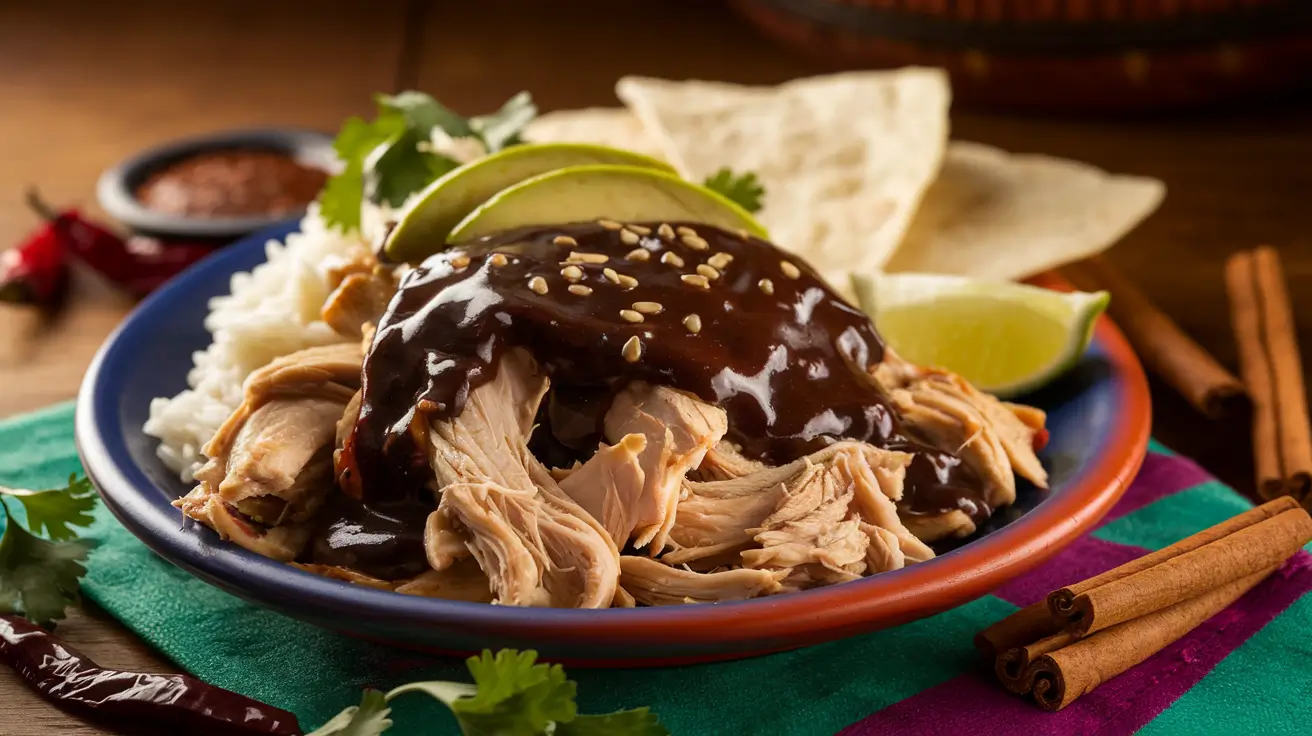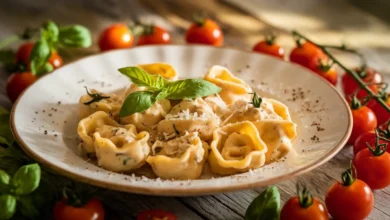Easy Slow Cooker Chicken Mole: A Culinary Journey Through Flavor and Tradition

Table of Contents:
- Introduction
- The Rich History of Mole
- Understanding the Complexity of Mole
- Why Use a Slow Cooker for Chicken Mole?
- Ingredients for Easy Slow Cooker Chicken Mole
- Step-by-Step Recipe
- Variations of Mole
- Pairing and Serving Suggestions
- Health Benefits of Mole Ingredients
- Troubleshooting Common Issues
- Storing and Reheating
- Frequently Asked Questions
- Conclusion
1. Introduction
Welcome, food enthusiasts and culinary adventurers! I’m Chef Maria Rodriguez, with over two decades of experience in Mexican cuisine. Today, I’m thrilled to guide you through the intricate world of mole, specifically focusing on an easy slow cooker chicken mole recipe that will tantalize your taste buds and impress your dinner guests.
Mole, pronounced “MOH-lay,” is more than just a sauce; it’s a culinary testament to Mexico’s rich cultural heritage. This complex dish, with its deep flavors and aromatic spices, has been a cornerstone of Mexican cuisine for centuries. While traditional mole recipes can be time-consuming and labor-intensive, our slow cooker version simplifies the process without compromising on taste.
In this comprehensive guide, we’ll explore the history of mole, break down its complex flavors, and walk through an easy-to-follow recipe that utilizes the convenience of a slow cooker. Whether you’re a seasoned chef or a curious home cook, this post will equip you with the knowledge and skills to create a delicious chicken mole that honors tradition while fitting into your busy lifestyle.
So, let’s embark on this flavorful journey and unlock the secrets of easy slow cooker chicken mole!
2. The Rich History of Mole
To truly appreciate mole, we must first understand its origins. The word “mole” comes from the Nahuatl word “molli,” meaning sauce or concoction. Its history is as rich and complex as its flavor profile.
Origins and Legends
The exact origins of mole are shrouded in legend. One popular story dates back to the 16th century in the convent of Santa Rosa in Puebla de los Ángeles. According to this tale, the nuns scrambled to prepare a dish for an unexpected visit from the archbishop. They combined various ingredients they had on hand – chocolate, chili peppers, nuts, and more – creating what we now know as mole poblano.
Another legend attributes the creation of mole to the Aztec king Moctezuma, who supposedly served it to the Spanish conquistadors as a dish fit for gods. While these stories add to mole’s mystique, the truth is likely a combination of indigenous Mesoamerican and Spanish influences over centuries of culinary evolution.
Cultural Significance
Mole is more than just a dish; it’s a symbol of Mexican culture and identity. It’s often served at celebrations and festivals, particularly mole poblano, which is considered the national dish of Mexico. The complexity of mole represents the blending of cultures and traditions that define Mexican heritage.
In many regions of Mexico, preparing mole is a communal activity, with recipes passed down through generations. Each family may have its own secret ingredient or technique, making every mole unique.
Evolution of Mole
While mole poblano (characterized by its use of chocolate) is perhaps the most famous variety, there are actually dozens of different types of mole throughout Mexico. Each region has its own variation, influenced by local ingredients and tastes. For example:
- Mole negro from Oaxaca is known for its deep, almost black color and complex flavor.
- Mole verde uses pumpkin seeds and green herbs for a fresher taste.
- Mole amarillo has a golden color and often includes tomatillos.
Over time, mole has also found its way into international cuisine, with chefs around the world incorporating its flavors into fusion dishes.
3. Understanding the Complexity of Mole
The beauty of mole lies in its complexity. A traditional mole sauce can contain anywhere from 20 to over 30 ingredients, each playing a crucial role in the final flavor profile.
Key Components of Mole
- Chili Peppers: The backbone of mole, providing heat and depth. Common varieties include ancho, pasilla, and mulato chilies.
- Nuts and Seeds: These add richness and help thicken the sauce. Peanuts, almonds, and sesame seeds are frequently used.
- Chocolate: Contrary to popular belief, not all moles contain chocolate. When used, it adds depth and slight bitterness, not sweetness.
- Fruit: Raisins, plantains, or dried fruit contribute subtle sweetness and complexity.
- Spices: Cinnamon, cloves, anise, and black pepper are common, adding aromatic notes.
- Herbs: Fresh or dried herbs like oregano and thyme enhance the overall flavor profile.
- Thickeners: Tortillas or bread are often used to give mole its characteristic consistency.
The Balance of Flavors
What makes mole truly special is the balance of its flavors. A well-made mole should have:
- Depth from the chilies and spices
- Richness from the nuts and seeds
- A hint of sweetness from fruit or sugar
- Subtle bitterness (if chocolate is used)
- Umami from tomatoes or tomatillos
Achieving this balance is an art form, often requiring years of experience and a refined palate.
4. Why Use a Slow Cooker for Chicken Mole?
Traditional mole recipes can be intimidating, often requiring hours of preparation and constant attention. This is where the slow cooker comes to the rescue, offering several advantages:
- Convenience: Set it and forget it. The slow cooker allows you to prepare the ingredients, combine them, and let the magic happen while you go about your day.
- Depth of Flavor: Slow cooking allows the flavors to meld and develop over time, resulting in a rich, complex sauce.
- Tender Chicken: The low, slow cooking process ensures that the chicken remains juicy and tender, easily absorbing the flavors of the mole.
- Consistency: Slow cooking helps achieve the perfect thick consistency without the risk of burning or sticking that can occur on the stovetop.
- Energy Efficiency: Slow cookers use less energy than conventional ovens, making them an eco-friendly option.
- Less Cleanup: One-pot cooking means fewer dishes to wash at the end of the meal preparation.
- Batch Cooking: Slow cookers are perfect for making larger batches, allowing you to freeze portions for future meals.
While purists might argue that slow cooker mole isn’t “authentic,” the truth is that it’s an excellent way for home cooks to enjoy this complex dish without spending an entire day in the kitchen. The key is to use high-quality ingredients and respect the fundamental flavors of mole.
5. Ingredients for Easy Slow Cooker Chicken Mole
Now that we understand the basics of mole and the benefits of using a slow cooker, let’s dive into the ingredients you’ll need for our easy slow cooker chicken mole recipe. This recipe serves 6-8 people.
For the Chicken:
- 3 lbs (1.4 kg) boneless, skinless chicken thighs
- Salt and pepper to taste
For the Mole Sauce:
- 3 dried ancho chilies, stemmed and seeded
- 2 dried guajillo chilies, stemmed and seeded
- 1 chipotle chili in adobo sauce
- 1 medium onion, roughly chopped
- 4 garlic cloves, peeled
- 1 ripe tomato, quartered
- 1/4 cup (60 ml) vegetable oil
- 1/3 cup (50 g) almonds
- 1/4 cup (40 g) raisins
- 2 tablespoons sesame seeds
- 1 corn tortilla, torn into pieces
- 2 tablespoons peanut butter
- 2 ounces (60 g) dark chocolate (70% cocoa or higher), chopped
- 1 teaspoon dried oregano
- 1/2 teaspoon ground cinnamon
- 1/4 teaspoon ground cloves
- 1/4 teaspoon ground anise seed
- 2 cups (480 ml) chicken broth
- Salt to taste
For Serving:
- Cooked rice
- Warm tortillas
- Sliced avocado
- Chopped fresh cilantro
- Lime wedges
- Crumbled queso fresco (optional)
6. Step-by-Step Recipe
Now, let’s walk through the process of creating our easy slow cooker chicken mole:
Step 1: Prepare the Chilies
- Heat a large skillet over medium heat. Toast the ancho and guajillo chilies for about 30 seconds on each side, until fragrant. Be careful not to burn them.
- Transfer the toasted chilies to a bowl and cover with hot water. Let them soak for 30 minutes to soften.
- Drain the chilies, reserving 1/2 cup of the soaking liquid.
Step 2: Prepare the Other Ingredients
- In the same skillet, heat 2 tablespoons of vegetable oil over medium heat.
- Add the onion, garlic, and tomato. Cook for about 5 minutes, until the onion is translucent and the tomato has softened.
- Transfer this mixture to a blender.
Step 3: Toast the Nuts and Seeds
- In the same skillet, toast the almonds, sesame seeds, and torn tortilla pieces until golden brown, about 2-3 minutes.
- Add these to the blender along with the raisins.
Step 4: Blend the Sauce
- Add the soaked chilies, chipotle chili, peanut butter, chocolate, oregano, cinnamon, cloves, and anise to the blender.
- Pour in the reserved chili soaking liquid and 1 cup of chicken broth.
- Blend until smooth, scraping down the sides as necessary.
Step 5: Cook the Sauce
- Heat the remaining 2 tablespoons of oil in the skillet over medium heat.
- Carefully pour in the blended sauce (it may splatter).
- Cook, stirring constantly, for about 5 minutes until the sauce has darkened and thickened slightly.
Step 6: Slow Cook
- Season the chicken thighs with salt and pepper and place them in the slow cooker.
- Pour the mole sauce over the chicken, making sure all pieces are well coated.
- Add the remaining 1 cup of chicken broth.
- Cover and cook on low for 6-8 hours, or on high for 3-4 hours, until the chicken is tender and easily shreds with a fork.
Step 7: Finish and Serve
- About 30 minutes before serving, shred the chicken in the slow cooker using two forks.
- Stir to ensure the chicken is well-coated with the sauce.
- Taste and adjust seasoning if necessary.
- Serve over rice with warm tortillas on the side.
- Garnish with sliced avocado, chopped cilantro, lime wedges, and crumbled queso fresco if desired.
7. Variations of Mole
While our recipe focuses on a simplified version of mole poblano, there are numerous regional variations of mole throughout Mexico. Here are a few you might want to explore:
Mole Negro
Originating from Oaxaca, mole negro is known for its intense, almost black color. It typically includes a variety of chilies, chocolate, and unique ingredients like hoja santa leaves and avocado leaves.
Mole Verde
This green mole is lighter and fresher than its darker counterparts. It often includes green ingredients like pumpkin seeds, tomatillos, jalapeños, and herbs like cilantro and epazote.
Mole Amarillo
Yellow in color, this mole is common in Oaxaca and often includes yellow chilies, tomatillos, and sometimes turmeric for additional color.
Mole Coloradito
Another Oaxacan variety, mole coloradito has a reddish color and typically includes ancho chilies, chocolate, and various spices.
Pipián
While technically a different sauce, pipián is sometimes considered a type of mole. It’s made primarily from pumpkin seeds and can be green or red depending on the other ingredients used.
Feel free to experiment with these variations in your slow cooker. While the cooking method may be the same, the different combinations of ingredients can lead to exciting new flavors.
8. Pairing and Serving Suggestions
Mole is a versatile sauce that pairs well with various dishes. Here are some serving suggestions to make the most of your slow cooker chicken mole:
Traditional Pairings
- Rice: A bed of fluffy white rice is the classic accompaniment to mole. The neutral flavor of the rice balances the complex flavors of the sauce.
- Tortillas: Warm corn tortillas are perfect for scooping up the mole and creating impromptu tacos.
- Beans: Refried beans or whole cooked beans make an excellent side dish, adding protein and fiber to the meal.
Vegetable Sides
- Grilled Vegetables: Zucchini, bell peppers, and onions grilled with a touch of olive oil complement the rich mole sauce.
- Roasted Sweet Potatoes: The sweetness pairs well with the complex flavors of mole.
- Mexican-style Corn (Elote): Grilled corn on the cob topped with mayo, cheese, chili powder, and lime juice adds a fun, festive touch to your meal.
Beverage Pairings
- Red Wine: A medium-bodied red wine like Zinfandel or Malbec can stand up to the bold flavors of mole.
- Mexican Beer: A light lager can help cleanse the palate between bites.
- Horchata: This sweet rice drink can balance the heat and complexity of the mole.
- Mezcal: For the adventurous, a smoky mezcal can complement the earthy flavors in the mole.
Creative Serving Ideas
- Mole Enchiladas: Use leftover chicken mole to fill enchiladas for a delicious next-day meal.
- Mole Nachos: Drizzle mole over tortilla chips with melted cheese for a unique twist on nachos.
- Mole Burrito Bowl: Create a burrito bowl with rice, beans, chicken mole, and your favorite toppings.
- Mole Quesadillas: Use chicken mole as a filling for quesadillas along with melty cheese.
Remember, the key to serving mole is to let it be the star of the show. Simple, complementary sides work best to highlight its complex flavors.
9. Health Benefits of Mole Ingredients
While mole is often considered an indulgent dish, many of its ingredients offer significant health benefits. Let’s explore some of the nutritional advantages of key mole components:
Chilies
- Rich in Vitamins: Chilies are high in vitamins A and C, which support immune function and skin health.
- Capsaicin: This compound gives chilies their heat and may boost metabolism and have anti-inflammatory properties.
Chocolate (Dark)
- Antioxidants: Dark chocolate is rich in flavonoids, which may help protect against heart disease.
- Mood Booster: Contains compounds that can improve mood and cognitive function.
Nuts and Seeds
- Healthy Fats: Almonds and sesame seeds provide heart-healthy monounsaturated fats.
- Protein: These ingredients add a plant-based protein boost to the dish.
- Minerals: Rich in minerals like magnesium, zinc, and selenium.
Spices (Cinnamon, Cloves, Anise)
- Anti-inflammatory: Many spices have anti-inflammatory properties.
- Blood Sugar Regulation: Cinnamon may help regulate blood sugar levels.
- Digestive Aid: Spices like cloves and anise can aid in digestion.
Tomatoes
- Lycopene: A powerful antioxidant that may reduce the risk of certain cancers.
- Vitamins: Rich in vitamins C and K.
Garlic and Onions
- Heart Health: May help lower blood pressure and cholesterol levels.
- Antibacterial Properties: Both have natural antibacterial and antifungal properties.
Chicken
- Lean Protein: Chicken, especially when using skinless thighs, is a good source of lean protein.
- B Vitamins: Rich in B vitamins, which are crucial for energy metabolism.
While mole is calorie-dense due to its ingredients, it’s packed with nutrients. Enjoying it in moderation as part of a balanced diet can contribute to overall health and wellness.
10. Troubleshooting Common Issues
Even with a foolproof slow cooker recipe, you might encounter some challenges. Here are solutions to common issues:
Sauce is Too Thin
- Remove the lid and cook on high for 30-60 minutes to reduce the sauce.
- Mix 1 tablespoon of cornstarch with 2 tablespoons of cold water, then stir this slurry into the mole.
Sauce is Too Thick
- Gradually add warm chicken broth or water until desired consistency is reached.
- Remember, the sauce will thicken as it cools, so it’s okay if it seems a bit thin while hot.
Mole is Too Spicy
- Add a dollop of sour cream or Mexican crema to individual servings to balance the heat.
- Incorporate more nut butter or a small amount of sugar to counteract the spiciness.
Mole Lacks Depth of Flavor
- Add a small amount of dark chocolate or cocoa powder.
- Incorporate a splash of vinegar or lime juice to brighten the flavors.
- Toast additional spices and add them to the sauce.
Chicken is Dry
- Ensure you’re not overcooking. Chicken thighs are more forgiving than breasts.
- If using chicken breasts, consider reducing the cooking time.
Mole Has a Bitter Taste
- Add a small amount of sugar or honey to balance the bitterness.
- Incorporate more tomato or a splash of vinegar to counteract bitterness.
Mole Separates or Looks Oily
- Whisk the sauce vigorously to reincorporate any separated oils.
- If persistent, blend a portion of the sauce and mix it back in.
Remember, mole is a forgiving sauce, and small adjustments can often rectify any issues. Don’t be afraid to taste and adjust as you go.
11. Storing and Reheating
Proper storage and reheating are crucial for maintaining the quality and safety of your chicken mole. Here are some guidelines:
Storing
- Refrigeration:
- Cool the mole to room temperature within 2 hours of cooking.
- Store in an airtight container in the refrigerator.
- Consume within 3-4 days for best quality.
- Freezing:
- Mole sauce freezes exceptionally well, with or without the chicken.
- Use freezer-safe containers or heavy-duty freezer bags.
- Leave some space for expansion if freezing in containers.
- Label with the date and contents.
- Frozen mole can last up to 3 months.
Reheating
- From Refrigerated:
- Stovetop: Heat in a saucepan over medium-low heat, stirring occasionally. Add a splash of broth if needed to thin the sauce.
- Microwave: Heat in short intervals, stirring between each to ensure even heating.
- From Frozen:
- Thaw overnight in the refrigerator for best results.
- Once thawed, reheat using the methods above.
- If reheating directly from frozen, use a low heat setting and stir frequently to prevent scorching.
Tips for Best Results
- When reheating, the mole may thicken. Add small amounts of broth or water to reach desired consistency.
- For food safety, ensure the internal temperature reaches 165°F (74°C) when reheating.
- Consider storing the mole sauce separately from rice or other accompaniments to prevent them from becoming soggy.
- Freeze in portion-sized containers for easy future meals.
Properly stored and reheated, your slow cooker chicken mole can be enjoyed for several days after initial preparation, making it an excellent option for meal prep or batch cooking.
12. Frequently Asked Questions
To address common queries about making slow cooker chicken mole, here are answers to frequently asked questions:
Q1: Can I use chicken breasts instead of thighs?
A: Yes, you can use chicken breasts, but they may become drier than thighs. If using breasts, consider reducing the cooking time by 1-2 hours and check for doneness earlier.
Q2: Is it necessary to use all the different types of chilies mentioned?
A: While using a variety of chilies adds complexity to the flavor, you can simplify by using just one or two types. Ancho chilies are a good all-purpose option if you’re choosing just one.
Q3: Can I make this recipe vegetarian or vegan?
A: Absolutely! Replace the chicken with vegetables like sweet potatoes, butternut squash, and bell peppers. Use vegetable broth instead of chicken broth. For a vegan version, ensure your chocolate is dairy-free.
Q4: How spicy is this mole?
A: This recipe is moderately spicy. You can adjust the heat level by changing the number of chilies used or by removing the seeds (which contain much of the heat) before use.
Q5: Can I make mole sauce ahead of time?
A: Yes! Mole sauce can be made in advance and stored in the refrigerator for up to a week or frozen for up to 3 months. This can be a great time-saver.
Q6: What if I don’t have a slow cooker?
A: You can adapt this recipe for stovetop cooking. Simmer the chicken in the mole sauce in a covered pot over low heat for about 2-3 hours, stirring occasionally and adding broth if needed.
Q7: Is there a quick version of mole?
A: While traditional mole is a complex, time-consuming dish, you can create a simplified version using pre-made mole paste combined with broth and a few additional ingredients. However, the depth of flavor won’t be the same as a from-scratch version.
Q8: Can I use mole for dishes other than chicken?
A: Absolutely! Mole is versatile and pairs well with pork, beef, enchiladas, or even vegetarian dishes like roasted vegetables or tofu.
Q9: How do I know when the mole is done cooking?
A: The mole is done when the chicken is tender and easily shreds with a fork. The sauce should be thick and fragrant, with all flavors well-melded.
Q10: Can I reduce the amount of oil used in the recipe?
A: While some oil is necessary for developing flavors and achieving the right consistency, you can reduce it slightly. However, be cautious as this may affect the final texture and richness of the mole.
13. Conclusion
Congratulations! You’ve now embarked on a culinary journey through the rich world of mole, armed with knowledge about its history, complexity, and the convenience of preparing it in a slow cooker. This easy slow cooker chicken mole recipe opens up a world of flavor that once seemed accessible only to the most dedicated chefs.
Remember, mole is more than just a sauce; it’s a celebration of Mexican culture and culinary artistry. By creating this dish in your own kitchen, you’re participating in a tradition that spans centuries and connects people across generations and borders.
Don’t be intimidated by the list of ingredients or the steps involved. The beauty of using a slow cooker is that it does most of the work for you, allowing the flavors to meld and develop into a rich, complex sauce that will impress your family and guests.
Feel free to experiment with the recipe once you’re comfortable with the basics. Try different combinations of chilies, adjust the sweetness or heat to your liking, or even create fusion dishes that incorporate mole into non-traditional recipes. The possibilities are endless!
Most importantly, enjoy the process. Cooking should be a joyful experience, and there’s something truly special about filling your home with the aromatic scents of mole simmering in the slow cooker.
So, gather your ingredients, fire up that slow cooker, and get ready to savor the deep, complex flavors of homemade chicken mole. Your culinary adventure awaits!
¡Buen provecho! (Enjoy your meal!)




